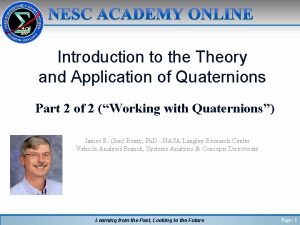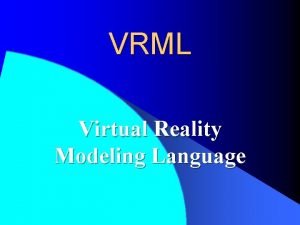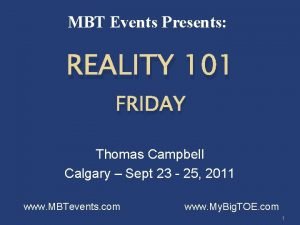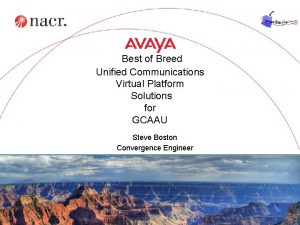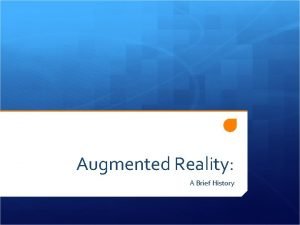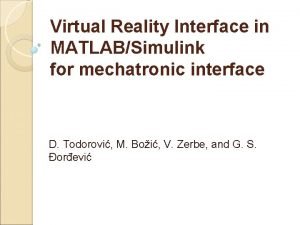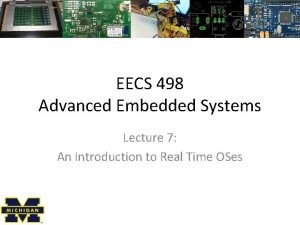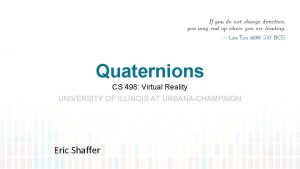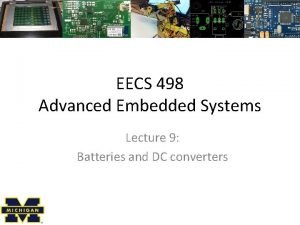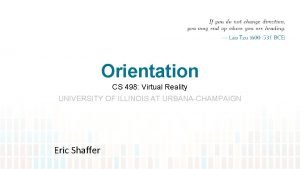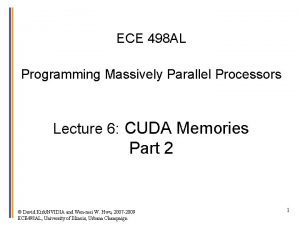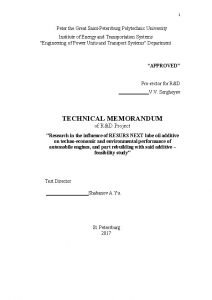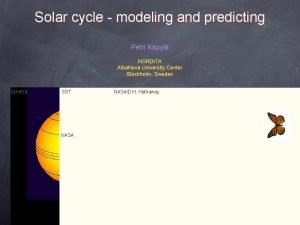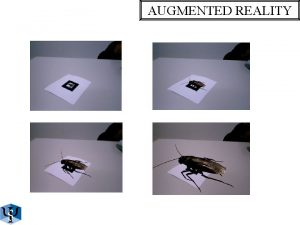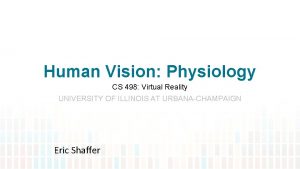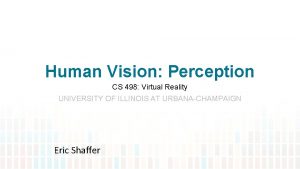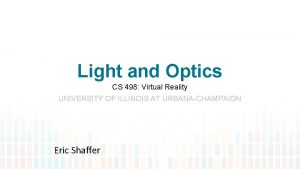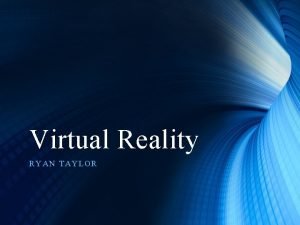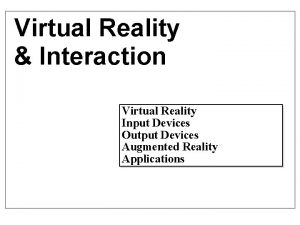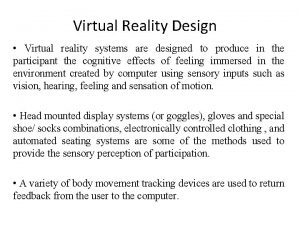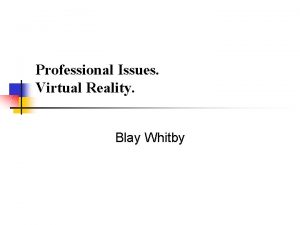Quaternions CS 498 Virtual Reality UNIVERSITY OF ILLINOIS







![Quaternions • Alternative to Euler Angles • Developed by Sir William Rowan Hamilton [1843] Quaternions • Alternative to Euler Angles • Developed by Sir William Rowan Hamilton [1843]](https://slidetodoc.com/presentation_image_h/91411719c99466cd208541a64381f742/image-8.jpg)
![Quaternions • Introduced to Computer Graphics by Shoemake [1985] • Given an angle and Quaternions • Introduced to Computer Graphics by Shoemake [1985] • Given an angle and](https://slidetodoc.com/presentation_image_h/91411719c99466cd208541a64381f742/image-9.jpg)















- Slides: 24

Quaternions CS 498: Virtual Reality UNIVERSITY OF ILLINOIS AT URBANA-CHAMPAIGN Eric Shaffer

Applying an Euler Angle Sequence Which axes are being rotated around in this sequence? M=Rz. Rx. Ry This is a very commonly used order…

Gimbal Lock y • Airplane orientation • Rz(roll) Rx(pitch) Ry(yaw) • Two axes have collapsed onto each other • Think about this from a user-interface perspective Imagine you have 3 dials…one for each angle What action caused the orientation you see? What happens when z dial is moved now? What problem could this cause for someone playing a game with this interface? x -z

Thinking about Gimbal Lock M=Rz. Rx. Ry In what order are the transformations applied to the points? Which axis and angle(s) can cause Gimbal Lock? Y? X? Z?

Experiment http: //danceswithcode. net/engine eringnotes/rotations_in_3 d/demo 3 D/rotations_in_3 d_tool. html

Is Gimbal Lock that Important? “In the video game industry there has been some back-and -forth battles about whether this problem is crucial. In an FPS game, the avatar is usually not allowed to pitch his head all the way to ±π/2, thereby avoiding this problem. In VR, it happens all the time that a user could pitch her head straight up or down. The kinematic singularity often causes the viewpoint to spin uncontrollably…” -- Virtual Reality by Lavalle Section 3. 3

Euler’s Rotation Theorem (1775) In geometry, Euler's rotation theorem states that, in threedimensional space, any displacement of a rigid body such that a point on the rigid body remains fixed, is equivalent to a single rotation about some axis that runs through the fixed point. It also means that the composition of two rotations is also a rotation. --Wikipedia Is an angle-axis representation of an orientation unique? This means that any set of Euler angles is equivalent to some single rotation around some axis. So, any orientation can be represented by and angle and an axis (i. e. a vector)
![Quaternions Alternative to Euler Angles Developed by Sir William Rowan Hamilton 1843 Quaternions • Alternative to Euler Angles • Developed by Sir William Rowan Hamilton [1843]](https://slidetodoc.com/presentation_image_h/91411719c99466cd208541a64381f742/image-8.jpg)
Quaternions • Alternative to Euler Angles • Developed by Sir William Rowan Hamilton [1843] • Quaternions are 4 -D complex numbers • With one real axis • And three imaginary axes: i, j, k TL; DL It turns out that quaternions are effectively an angle-axis representation of an orientation…just think of them as a way of encoding that information Hamilton Math Inst. , Trinity College
![Quaternions Introduced to Computer Graphics by Shoemake 1985 Given an angle and Quaternions • Introduced to Computer Graphics by Shoemake [1985] • Given an angle and](https://slidetodoc.com/presentation_image_h/91411719c99466cd208541a64381f742/image-9.jpg)
Quaternions • Introduced to Computer Graphics by Shoemake [1985] • Given an angle and axis, easy to convert to and from quaternion • Euler angle conversion to and from arbitrary axis and angle difficult • Quaternions allow stable and constant interpolation of orientations • Cannot be done easily with Euler angles

Unit Quaternions • For convenience, we will use only unit length quaternions • These correspond to the set of 4 D vectors • They form the ‘surface’ of a 4 D hypersphere of radius 1

Quaternions as Rotations • A quaternion can represent a rotation by angle θ around a unit vector a: • If a is unit length, then q will be also

A Rotation Quaternion is Unit-Length

Rotation using Quaternions • • We haven’t talked about how to multiply Let q = cos(q/2) + sin(q/2) u be a unit quaternion: |q| = |u| = 1 quaternions yet, but don’t worry about that for now… Let point p = (x, y, z) = x i + y j + z k • Then the product q p q-1 rotates the point p about axis u by angle q • Inverse of a unit quaternion is its conjugate …just negate the imaginary part q-1 = (cos(q/2) + sin(q/2) u)-1 = cos(-q/2) + sin(-q/2) u = cos(q/2) – sin(q/2) u q u p • Composition of rotations q 12 = q 1 q 2 q 1 q p q-1

Rotation using Quaternions • Let q = cos(q/2) + sin(q/2) u be a unit quaternion: |q| = |u| = 1 • Let point p = (x, y, z) = x i + y j + z k • Then the product q p q-1 rotates the point p about axis u by angle q • Inverse of a unit quaternion is its conjugate …just negate the imaginary part q-1 = (cos(q/2) + sin(q/2) u)-1 = cos(-q/2) + sin(-q/2) u = cos(q/2) – sin(q/2) u What would the identity quaternion look like? q u What are q 0, q 1, q 2, q 3 ? p • Composition of rotations q 12 = q 1 q 2 q 1 q p q-1

Quaternion to Matrix • To convert a quaternion to a rotation matrix: Again, why do we want to be able to do this?

Matrix to Quaternion • Matrix to quaternion is not hard • • it involves a few ‘if’ statements, a square root, three divisions, and some other stuff • tr(M) is the trace • sum of the diagonal elements

Quaternion Dot Products The dot product of two quaternions: The angle between two quaternions in 4 D space is half the angle one would need to rotate from one orientation to the other in 3 D space

Rotation using Quaternions “The angle between two quaternions in 4 D space is half the angle one would need to rotate from one orientation to the other in 3 D space…” Let φ be the angle between two orientations in 4 D space So, it’s the angle between 2 quaternions Q 1 and Q 2 in 4 D space That means that for some quaternion U we have Q 2 = U Q 1 Where U = (cos φ , sin φ Uq) The angle rotate through in 3 D Euclidean space will be 2φ

Quaternion Multiplication • We can perform multiplication on quaternions • we expand them into their complex number form • If q represents a rotation and q’ represents a rotation, qq’ represents q rotated by q’ • This follows very similar rules as matrix multiplication (i. e. , non-commutative) It’s just like multiplying 2 rotation matrices together….

Quaternion Multiplication • Two unit quaternions multiplied together results in another unit quaternion • This corresponds to the same property of complex numbers • Remember(? ) multiplication by complex numbers is like a rotation in the complex plane • Quaternions extend the planar rotations of complex numbers to 3 D rotations in space

Linear Interpolation • If we want to do a linear interpolation between two points a and b in normal space Lerp(t, a, b) = (1 -t)a + (t)b where t ranges from 0 to 1 • Note that the Lerp operation can be thought of as a weighted average (convex) • We could also write it in its additive blend form: Lerp(t, a, b) = a + t(b-a)

Spherical Linear Interpolation • If we want to interpolate between two points on a sphere (or hypersphere), we do not just want to Lerp between them • Instead, we will travel across the surface of the sphere by following a ‘great arc’ If we lerped between 2 unit quaternions would our interpolated quaternions be valid orientations?

Spherical Linear Interpolation • The spherical linear interpolation of two unit quaternions a and b is: Quick quiz: explain what the angle theta is? What space is it in?

Quaternion Interpolation • Useful for animating objects between two poses • Not useful for all camera orientations • up vector can become tilted annoy viewers • depends on application • Interpolated path through SLERP rotates • around a fixed axis • at a constant speed • so, no acceleration If we want to interpolate through a series of orientations q 1, q 2, …, qn is SLERP a good choice?
 Introduction to quaternions
Introduction to quaternions Virtual reality modeling language tutorial
Virtual reality modeling language tutorial Virtual world definition
Virtual world definition Virtual reality company in oman
Virtual reality company in oman Tom campbell virtual reality
Tom campbell virtual reality Make augmented reality business card
Make augmented reality business card What does vrml stand for
What does vrml stand for Patel v r
Patel v r Remote maintenance augmented reality
Remote maintenance augmented reality Virtual reality unified communications
Virtual reality unified communications Ivan sutherland head mounted display
Ivan sutherland head mounted display Conclusion for virtual reality
Conclusion for virtual reality Conclusion of virtual reality
Conclusion of virtual reality Virtual reality joke
Virtual reality joke Pros and cons of virtual reality in healthcare
Pros and cons of virtual reality in healthcare All children can learn slogan
All children can learn slogan Cs 498 vr
Cs 498 vr Eecs 498
Eecs 498 Cs498 dl
Cs498 dl Embedded systems
Embedded systems Quem pode o mais pode o menos
Quem pode o mais pode o menos Cs 498 vr
Cs 498 vr Ece 498
Ece 498 +1 (432) 498-0251
+1 (432) 498-0251 Kpyl
Kpyl
